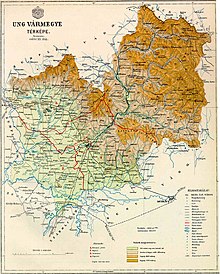Ung County
This article needs additional citations for verification. (November 2007) |
| Ung County | |
|---|---|
| County of the Kingdom of Hungary (11th century-1544) County of the Eastern Hungarian Kingdom (1544-1564) County of the Kingdom of Hungary (1564-1920, 1938-1945) | |
 | |
| Capital | Ungvár (now Uzhhorod) |
| Area | |
| • Coordinates | 48°37′N 22°18′E / 48.617°N 22.300°E |
• 1910 | 3,230 km2 (1,250 sq mi) |
| Population | |
• 1910 | 162,089 |
| History | |
• Established | 11th century |
• Treaty of Trianon | 4 June 1920 |
• Merged into Szabolcs-Ung County | 1923 |
• County recreated (First Vienna Award) | 2 November 1938 |
• Disestablished | 1945 |
| Today part of | Ukraine (2,795 km2) Slovakia (16 km2) |
Ung County (in Latin: comitatus Unghvariensis; Hungarian: Ung (vár)megye; also in Slovak: Užský komitát/ Užská župa / Užská stolica; Romanian: Comitatul Ung) was an administrative county (comitatus) of the Kingdom of Hungary. Its territory is now mostly in western Ukraine, a smaller part in eastern Slovakia, and a very small area in Hungary.
Geography
[edit]
Ung county shared borders with the Austrian crownland Galicia (now in Poland and Ukraine) and the Hungarian counties Bereg, Szabolcs and Zemplén. It was situated between the Carpathian Mountains in the north, the rivers Tisza and Latorca (present-day Latorica) in the south, and the river Laborc (present-day Laborec) in the west. The rivers Latorca and Ung (present-day Uzh) flowed through the county. Its area was 3230 km² around 1910.
Capitals
[edit]Initially, the capital of the county was the Uzhhorod Castle (Hungarian: Ungvári vár), later the town of Ungvár (present-day Uzhhorod).
History
[edit]Ung is one of the oldest counties of the Kingdom of Hungary. In the aftermath of World War I, most of Ung county became part of newly formed Czechoslovakia, as recognized by the concerned states in the 1920 Treaty of Trianon. The town of Záhony and the village of Győröcske remained in Hungary, which was merged into Szabolcs-Ung County in 1923.
Following the provisions of the First Vienna Award, all but the westernmost part of the county became part of Hungary again in November 1938, and the county was recreated. In 1939, following the annexation of the remainder of Carpathian Ruthenia after Czechoslovakia became abolished, the rest of the territories became part of Hungary again, however those were assigned to the administrative branch offices of Ung.
After World War II, as the 1920 borders were restored, the westernmost part was returned to Czechoslovakia. The rest (except Záhony and Győröcske) became part of the Soviet Union, Ukrainian SSR, Zakarpattia Oblast, while a small part remained in Hungary.
Demographics
[edit]
| Census | Total | Ruthenian | Hungarian | Slovak | German | Other or unknown |
|---|---|---|---|---|---|---|
| 1880[1] | 126,707 | 42,095 (34.25%) | 39,479 (32.12%) | 36,920 (30.04%) | 3,614 (2.94%) | 795 (0.65%) |
| 1890[2] | 135,247 | 46,521 (34.40%) | 37,182 (27.49%) | 40,035 (29.60%) | 10,318 (7.63%) | 1,191 (0.88%) |
| 1900[3] | 153,266 | 55,742 (36.37%) | 46,306 (30.21%) | 42,876 (27.97%) | 7,099 (4.63%) | 1,243 (0.81%) |
| 1910[4] | 162,089 | 61,711 (38.07%) | 53,824 (33.21%) | 36,364 (22.43%) | 8,383 (5.17%) | 1,807 (1.11%) |
| Census | Total | Greek Catholic | Roman Catholic | Calvinist | Jewish | Other or unknown |
|---|---|---|---|---|---|---|
| 1880 | 126,707 | 65,128 (51.40%) | 27,466 (21.68%) | 17,238 (13.60%) | 16,423 (12.96%) | 452 (0.36%) |
| 1890 | 135,247 | 72,190 (53.38%) | 28,836 (21.32%) | 18,056 (13.35%) | 15,599 (11.53%) | 566 (0.42%) |
| 1900 | 153,266 | 83,936 (54.76%) | 32,904 (21.47%) | 19,003 (12.40%) | 16,776 (10.95%) | 647 (0.42%) |
| 1910 | 162,089 | 89,149 (55.00%) | 34,549 (21.31%) | 20,092 (12.40%) | 17,587 (10.85%) | 712 (0.44%) |
Nowadays, some Romanians living in the area of Poroshkovo also inhabit the area of Ung. They are known as volohi in Romanian.[5]
Subdivisions
[edit]
In the early 20th century, the subdivisions of Ung county were:
| Districts (járás) | |
|---|---|
| District | Capital |
| Nagyberezna | Nagyberezna (now Velykyi Bereznyi) |
| Nagykapos | Nagykapos (now Veľké Kapušany) |
| Perecseny | Perecseny (now Perechyn) |
| Szerednye | Szerednye (now Serednye) |
| Szobránc | Szobránc (now Sobrance) |
| Ungvár | Ungvár (now Uzhhorod) |
| Urban districts (rendezett tanácsú város) | |
| Ungvár (now Uzhhorod) | |
The towns of Veľké Kapušany and Sobrance are now in Slovakia; the other towns mentioned are in Ukraine.
Notes
[edit]References
[edit]- ^ "Az 1881. év elején végrehajtott népszámlálás főbb eredményei megyék és községek szerint rendezve, II. kötet (1882)". library.hungaricana.hu. Retrieved September 28, 2021.
- ^ "A Magyar Korona országainak helységnévtára (1892)". library.hungaricana.hu. Retrieved September 29, 2021.
- ^ "A MAGYAR KORONA ORSZÁGAINAK 1900". library.hungaricana.hu. Retrieved September 29, 2021.
- ^ "KlimoTheca :: Könyvtár". Kt.lib.pte.hu. Retrieved September 29, 2021.
- ^ Peiu, Petrisor (February 2, 2020). "Și ei sunt români. Și ei sunt ai noștri. Și ei au nevoie de România". Ziare.com (in Romanian).


